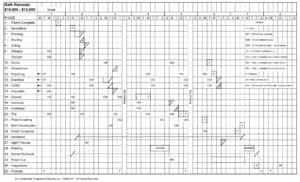
I recently heard a speaker say that problems are often caused by the things we don’t see. He was talking about our personal lives, but it certainly applies to construction as well, especially when it comes to job delays.
Example: The framing is almost finished on a new addition. You check with the job foreperson to make sure he scheduled the delivery of the windows Monday morning. He responds with, “Where are the windows now?”
Where are they? The job foreperson was supposed to make sure the supplier had those windows in the warehouse, ready to ship when you called. There are other variations of this scenario: the foreperson might say he wasn’t told about the windows, or he didn’t know it was his job to track them, or it wasn’t his job to schedule delivery, or he’s tried but the supplier isn’t returning calls, etc.
Example: You call your plumber or electrician to schedule the rough-in for the new addition. This isn’t your first notice; you called them before and/or sent a written notice to schedule the start date, but now you hear, “I can’t make that date, we got behind on another job,” or “We have a big job that just came in and we can’t afford to pass it up,” or “We’re really short on help right now, we can’t start your job for at least another two weeks.”
Example: During your weekly inspection of jobs in progress, you realize that a new addition is falling behind schedule. When you ask the job foreperson why, he gives you any number of reasons: weather slowed the job down, rain caused so much mud that they can’t get materials in, the drywall guy was two days late getting started, drywall only has one person on the job because they sent the rest of the crew to other jobs, the supplier can’t get the roofing materials for another week, the concrete guy says it is raining too much to pour the patio slab, and so on.
These problems happen all the time in construction, and they’re made worse when you don’t see them coming. You can’t stop all problems but you can get ahead of them, and the way to do that is by using checklists. I talk about checklists throughout all three of our books and after 60+ years in this industry, I can’t think of a single other item that would help you avoid, or at least foresee, these problems or the other day to day “stuff” that happens so frequently.
You can’t prevent all delays on jobs. But you can get an idea of what’s coming at you by developing checklists for every job and reviewing them daily.
In my opinion, every job needs at least a Gantt Chart. It should be compiled and used on every job that is above a certain minimum size, either dollar amount or the number of projected days for that job. Gantt Charts should be compiled by the salesperson for the job in collaboration with production, so everyone knows and agrees to the schedule, who does what and when, before the contract is signed. We also talk about Gantt charts in our Profitable Estimating Training course.
You should also have job checklists that pertain to each type of work, such as kitchen remodels, bathrooms, room additions, whole house remodels. If you’re building new homes, you should have a checklist for each type of home you build. “Wait”, you say, “We build custom homes, no one checklist would work for us.” That’s fine, develop checklists that cover all the details that need to be done pre-job. Then make a checklist for inhouse work, specialty work, suppliers, etc. With a little thought, you can create checklists for every type of construction you can think of, residential or commercial.
Checklists have you look ahead by planning each job in detail. The more details you define with your checklists before the job starts, the fewer problems you’ll have as the job progresses.
Looking back at the examples, your job foreperson won’t be surprised about a window delivery because a checklist would have notified them that it was their job to order windows and schedule delivery, and when.
A checklist reminds you to call your subs 3 weeks, and 2 weeks, and again the week before they’re needed. Somewhere along the line you’ll pick up inklings if there is a problem brewing, and you can either adjust your schedule or warn them to meet your schedule or else, whichever seems best. If they flake out altogether because of a larger job, you have a record of repeated reminders that might encourage them to reconsider.
With a checklist, your job foreperson will know the day things start going wrong on the job so they can begin making adjustments. They can’t change the weather, but they can attempt to minimize the disruption.
You can always find a reason to not do something. Not enough time, too much thinking involved, I want to go fishing, whatever. But at some point, you need to decide to do the hard things so you can run your business like a business. In construction, that means creating and using checklists for every job. That is what’s needed if you want to make good money with fewer headaches.
The knowledge and experience Michael Stone gained in his 60+ years in construction has helped thousands of contractors improve their businesses and their lives. He is the author of the books Markup & Profit Revisited, Profitable Sales, and Estimating Construction Profitably, and is available for one-on-one consultations as needed.
Listen to the audio here, or select dots on the right to download:
